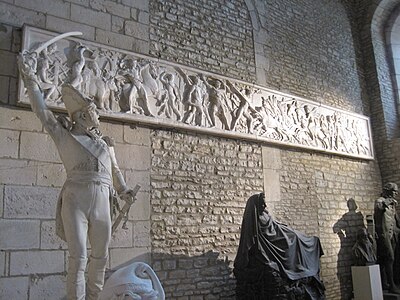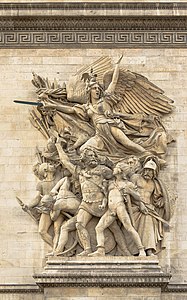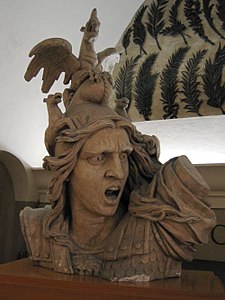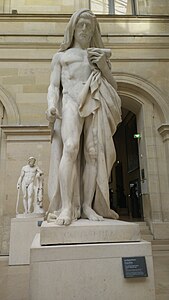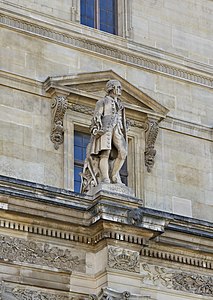François Rude
François Rude | |
|---|---|
Sophie Rude (1842) | |
| Born | 4 January 1784 Dijon, France |
| Died | 3 November 1855 (aged 71) Paris, France |
| Nationality | French |
| Known for | Sculpture, drawing |
| Awards | Legion of Honour |
François Rude (4 January 1784 – 3 November 1855) was a French
Early life
François Rude was born 4 January 1784 on rue Petite-Poissonnerie (rue François Rude) in Dijon. His father was a blacksmith and locksmith, who taught Rude the trade of forging iron, so he could take over the family business. In 1799, at the age of fifteen, despite his father's resistance, he began taking courses at the School of Fine Arts in Dijon, located within the Palace of the Dukes of Burgundy, while continuing to work in the family business. His teacher was the deputy curator of the Dijon museum, Louis Fremiet. Rude learned both drawing and sculpture, using classical models. Fremiet helped protect Rude from being drafted into Napoleon's army, and, in 1808, sent him to Paris to continue his studies.[3]
Rude began his studies at the Imperial
Exile in Brussels
Rude lived in Brussels from 1817 until 1826. where he found many other self-imposed exiles, the most famous of whom was the painter Jacques-Louis David. Rude's wife, a painter, became David's pupil and then his copyist.[5] In Brussels he made a bust of David, neoclassical in style, but realistically portraying the deformation of David's mouth caused by a nervous malady.
In Brussels he received his first major commission; he was asked by the Belgian royal architect
Return to Paris – classicism to romanticism
Brussels did not offer enough opportunities or challenges, and in 1827 Rude returned to Paris with Sophie and entered a work in the
Rude decided to move permanently to Paris in 1828. He found a client in the French state, which commissioned him, along with several others sculptors, to work on a frieze for the
-
A plaster molding of The Hunt of Meleager 1821–23, Rude Museum, Dijon
-
Mercury Fastening his Sandals After Killing Argos, 1827, The Louvre
-
Bust ofLa Pérouse, 1828
-
Neapolitan Fisher Boy Playing with a Tortoise, 1831–33, The Louvre
The Arc de Triomphe and Départ des Volontaires de 1792
The Arc de Triomphe had been begun in 1806 by Napoleon to celebrate his victory at the battle of Austerlitz. It had only reached a height of nine meters when Napoleon was overthrown, and it was abandoned for years. During Bourbon Restoration, Charles X of France had begun to work on it again, to make it a monument to celebrate the defeat of Spanish revolutionaries by a French royal expeditionary force. When Rude first arrived in Paris in 1828, based on his experience with the friezes in Tervuren, he became one of the sculptors working on the friezes, depicting the exploits of the royalist army in Spain.[3]
The
The Départ des volontaires de 1792 (Departure of the Volunteers of 1792), also known as La Marseillaise completed in 1836, became Rude's most famous work. It depicted the departure of a French revolutionary army to fight against a coalition of royalist forces at the Battle of Valmy in 1792. Sophie Fremiet, Rude's wife, posed for the principal figure, the Génie de la Guerre (Genius of the War), a woman with a sword shouting to urge others on to battle. The pose of this figure resembled the central figure of the painting by Delacroix, Liberty leading the People, which had been purchased by the French government at the 1831 Salon, and shown briefly at the Luxembourg Museum until 1833. The fierce shouting expression had been used earlier by Rude as a student at the academy, in the competition for best facial expressions, which he won in 1812.[3] The soldiers wore the costumes of warriors of ancient Gaul.[7] The Depart des Volontaires de 1792 immediately became famous for its vitality and energy, and as a celebration of the French revolutionary spirit. Auguste Rodin took up the same theme, with a similar shouting figure, in his La Defense (1879).[8]
-
Model of second version of Le Depart des Volontaires de 1792, in plaster, 1833, The Louvre
-
The Départ des Volontaires, 1836
-
Head of the Génie de la Guerre
-
Rude's wife Sophie Frémiet, a painter, posed for the Génie de la Guerre
-
The head of the Génie de la Guerre
-
François Rude working on the Arc de Triomphe, painting by Joseph-Noël Sylvestre, 1893
Patriotic and historical statuary
The critical and popular acclaim for the frieze on the Arc de Triomphe led to more commissions for Rude.
Louis-Philippe was driven into exile in 1848, and the new and brief
An unusual work in his period of patriotic sculptures was his tomb of Éléonore-Louis Godefroi Cavaignac, one of the leaders of the republican opposition to the monarchy, who had died in 1845. The sepulcher designed by Rude recalled those of the Middle Ages made for the Kings of France, particularly the tomb of Henry II of France sculpted by Germain Pilon. The figure of Cavaignac was depicted with great realism; the body was depicted under a plain sheet, and body was emaciated from his imprisonment by royal government. The sepulcher served a model for those of later opponents of the monarchy.[10]
Another notable example of his patriotic work was Napoleon Awakening to Immortality (1845). The statue was made for Claude Noisot, who a former captain in Napoleon's imperial guard and an officer of the Legion of Honor, who had accompanied Napoleon into exile on Elba, and at the Battle of Waterloo. He was unable to pursue a military career after Napoleon's downfall, but with the help of a wealthy wife purchased vineyards and an estate at Fixin in Burgundy. At the time that the statue was conceived, the political climate in Paris was still hostile to Napoleon, and there were no monuments to him in the city. Therefore, Noisot and Rude planned for the sculpture of the Emperor to be placed on Noisot's estate in Burgundy. The statue shows the Emperor, eyes closed, wearing a crown of laurel, under a military cloak, atop a rocky pedestal. An eagle, his symbol, is chained to the stone, and is crying out to awaken him, while the chains that held the Emperor have been broken. For years, elderly veterans of Napoleon's army made pilgrimages to Fixin to honor Rude's statue.[11]
-
Louis Philippe, 1832, The Louvre
-
Bust of Jacques-Louis David, 1838
-
The adolescent Louis XIII, 1843, Museum of Fine Arts, Lyon
-
Joan of Arc listening to her voices, 1845, The Louvre
-
Statue of the sculptor Jean-Antoine Houdon, 1847, facade of the Denon wing of the Louvre
-
Statue of Maréchal Michel Ney, 1853
-
Napoleon Awakening to Immortality, 1846, Parc Noisot, Fixin
-
Tomb of Éléonore-Louis Godefroi Cavaignac, 1847
Late works and death
Late works by Rude included a Calvary in
Rude received a medal for his lifetime work at the Paris International Exposition of 1855. Shortly afterwards, on 3 November 1855, Rude died at his Paris residence at rue d'Enfer 3. He was buried at Montparnasse Cemetery in Paris.
Toward the end of his life, Rude made several notable religious sculptures, including the sculptural decoration of a pulpit for the Church of St. Etienne in
The Dijon Museum of Fine Arts, the Musée d'Orsay and the Louvre have notable collections of his works.
-
Hebe and the Eagle of Jupiter, 1851, Dijon Museum of Fine Arts
-
Detail of Hebe and the Eagle of Jupiter, 1851
-
Baptism of Christ,Church of the Madeleine, Paris
-
The pulpit of the Church of St. Etienne, Lille
-
Love, dominator of the world, 1857, Dijon Museum of Fine Arts
-
Grave on Montparnasse Cemetery, sculpture by Paul Cabet, 1856
Pupils
Rude's pupil
Musée Rude
The Musée Rude in Dijon, inaugurated in 1947, is devoted to plaster casts of his works that were acquired by the city of Dijon, between 1887 and 1910; it is housed in the transept of the 11th-century church of Saint-Etienne in rue Vaillant.[12]
Bibliography
- Jeancolas, Claude (1992). Sculpture Française. Paris: CELIV. ISBN 2-86535-162-9.
See also
Notes and citations
- ^ Petit Robert Dictionnaire Universel des Noms Propres, p. 1569.
- ^ François et Sophe Rude, Edited by Laurence Caillaud, Dossier de l'Art Hors Série, (2012), Number 19.
- ^ a b c d e François et Sophe Rude, Edited by Laurence Caillaud, Dossier de l'Art Hors Série, (2012), pp. 22–23.
- ^ Caillaud, Francois et Sophie Rude (2012), pg. 16.
- ^ L. de Fourcaud, François Rude, sculpteur: ses oeuvres et son temps 1904, pp. 100–12, noted in Symmons 1973:595, note 25.
- ^ François et Sophe Rude, Edited by Laurence Caillaud, Dossier de l'Art Hors Série, (2012), pp. 16–19.
- ^ Rouge-Decos, Isabelle, Rude à L'Arc de Triomphe, in François et Sophe Rude, Edited by Laurence Caillaud, Dossier de l'Art Hors Série, (2012), p. 30.
- ^ Rouge-Decos, Isabelle, Rude à L'Arc de Triomphe, in François et Sophe Rude, Edited by Laurence Caillaud, Dossier de l'Art Hors Série, (2012), pp. 26–30.
- ^ a b Rouge-Decos, Isabelle, Rude et la célébration des Gloires Nationales, in François et Sophie Rude, Edited by Laurence Caillaud, Dossier de l'Art Hors Série, (2012), pp. 34–40.
- ^ Rouge-Decos, Isabelle, Rude et la célébration des Gloires Nationales, in François et Sophie Rude, Edited by Laurence Caillaud, Dossier de l'Art Hors Série, (2012), pp. 38–39.
- ^ Rouge-Decos, Isabelle, Rude et la célébration des Gloires Nationales, in François et Sophie Rude, Edited by Laurence Caillaud, Dossier de l'Art Hors Série, (2012), pp. 42–44.
- ^ "Musée Rude : Expositions & Arts Dijon". Archived from the original on 28 September 2007. Retrieved 31 May 2007.
External links
- Louvre Database (French language) – Works by Rude (and some others)
- More views of the Neapolitan Fisherboy
- Views of the Arc de Triomphe
- Art on-line: François Rude
- French language site listing works by Rude, with access to large images (it may be necessary to close an advertising banner to view this page)
- François Rude in American public collections, on the French Sculpture Census website

